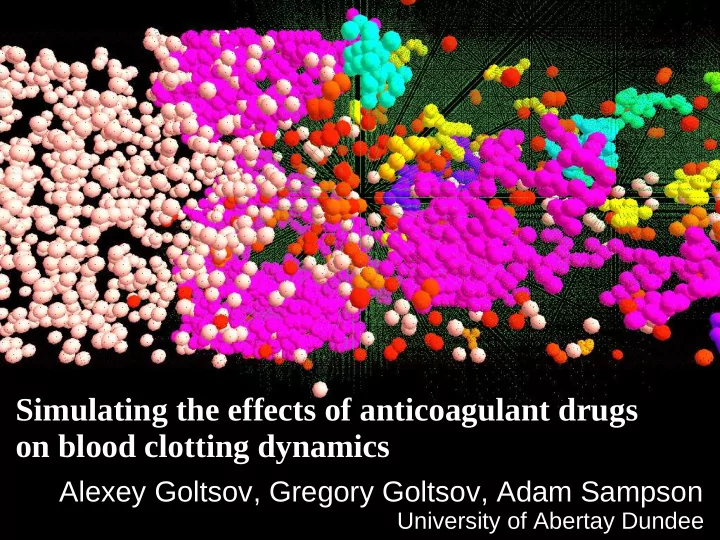

Simulating the effects of anticoagulant drugs Simulating the effects of anticoagulant drugs on blood clotting dynamics on blood clotting dynamics Alexey Goltsov, Gregory Goltsov, Adam Sampson University of Abertay Dundee
Blood clotting platelets in bloodstream
Blood clotting platelets in bloodstream damaged tissue
Blood clotting platelets in bloodstream damaged tissue emits clotting factors
Blood clotting platelets in platelets become bloodstream sticky chemical signalling damaged tissue emits clotting factors
Blood clotting platelets in platelets become clots form bloodstream sticky chemical mechanical signalling interaction damaged tissue emits clotting factors
● This process doesn't always work properly – Excessive clotting – e.g. thromboembolisms – Insufficient clotting ● To treat these problems, we use drugs to change the behaviour of platelets' signalling networks – … such as aspirin – … or specialised anticoagulants – … or – more interestingly – combinations of the above
● 2008: Carl Ritson et al. built a large-scale simulator of artificial platelets for the TUNA project; simple physics, but no real behaviour ● 2010: ATS rebuilt simulator using CoSMoS tech; same behaviour, but supports interactive use
● Meanwhile, AG was modelling platelet signalling under the effects of various drugs; good behaviour, but no physics ● Both the signalling and the physics matter! ● Combine the models?
So GG applied for – So GG applied for – and was awarded – and was awarded – a 2011 Nuffield Nuffield bursary bursary a 2011
● Identify signalling metamodel: hybrid Petri nets – … hybrid because they have continuous quantities rather than discrete tokens – … but the graphical language is convenient! ● Identify an appropriate (subset) signalling model based on AG's existing one ● Define a domain-specific language for hybrid Petri nets so we can automatically generate the code AG wrote by hand... ● Give each cell in the simulator its own Petri net
● Success! ● … that is, the technology works; we haven't yet calibrated the combined model ● Platelets can now amplify the damage signalling: you don't need to emit (unrealistically) large signals into the bloodstream any more ● Can adjust signalling model parameters in real time and see the physical effects
● Where next? Better metamodel tool support? ● We actually want to use this for cancer , rather than blood clotting – same modelling technologies, but more complex problems ● … for example, helping to design drugs that affect tumour morphology when growing into tissue – less invasive, easier to remove ● For this, we need a more sophisticated physical model too...
Jiujiang Zhu, MSc projects Ye Li, Ni Guo Ellipsoid cell model
Tim Newman, Dundee Tim Newman, Dundee ScEM finite-element cell model ScEM finite-element cell model
… achieving large scales through distribution achieving large scales through distribution …
… and experimenting with new interaction techniques and experimenting with new interaction techniques …
● Thanks to EPSRC, Nuffield, and our collaborators at York, Kent, Dundee, Edinburgh and St. Andrews ● Any questions?
Recommend
More recommend